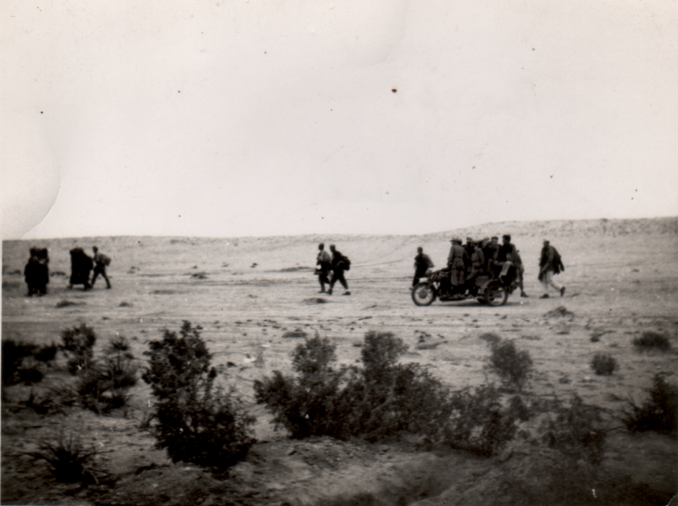
Previously unpublished photo courtesy of DJM’s uncle David, © 2021
The May of 80 years ago finally saw some desert action in Libya but not until later in the month, all the navies were busy attacking ships and the air forces were attacking everything. Convoys were still trying to reach both Libya and Malta. I think the Royal Navy was quite outstanding this month as they were in most of these months. They do not really get the recognition they deserve.
By the beginning of May it was discovered that three strips had been cleared near the Gerbini airfield in Sicily. Each strip was near a railway and it was obvious that preparations were in hand for an airborne invasion of Malta. The German gliders could easily be transported by rail and quickly assembled.
On the 4th May the pilots at Takali airfield were told that more Spitfires would arrive on the 9th May. The station commander wanted them all back in the air within 15 minutes of landing to avoid April’s fiasco when many had been destroyed or damaged shortly after landing.
On the 7th the new Governor, Lord Gort, arrived in Malta to be told that there were only 6 Spitfires capable of operational flights. On the 9th those six had to fly and cover the arrival of the 64 Spitfires coming from the USS Wasp and HMS Eagle of which 59 made it to Malta.
The evening of the 9th Field Marshal Kesselring in Sicily was furious. He wanted Malta bombed all night with another large load of bombs during the day. However Adolf had decided Malta was finished and had already started removing Luftwaffe aircraft, along with the losses in air combat, there were not as many planes as he would have liked. Meanwhile HMS Welshman, a fast minesweeper made its way to the Grand Harbour with delivery of anti-aircraft ammunition and Spitfire spare parts.
By the 11th May, the RAF had regained air superiority over Malta, welcome news to a delighted Churchill. By the 14th the Axis raids had calmed down a lot, they were much smaller and infrequent and were usually intercepted before reaching Malta. On the 18th HMS Eagle delivered another 16 Spitfires to Malta. There was much less bombing of Malta now but the Axis had decided to strangle the supplies to the island. The food shortage would become acute very quickly.
On the 1st an RAF Hudson bomber based at Gibraltar damaged U-573 near Algeria, the British then sent destroyers HMS Wishart and Wrestler to finish her off. The Axis sent U-74 and U-375 and Italian submarines Emo and Mocenigo to help U-573. On the 2nd U-573 reached Cartagena in Spain where she was impounded and the crew interned. U-74 was however found by the two British destroyers and sunk, all crew died. On the 3rd carrier USS Wasp left Glasgow with 47 Spitfires for Malta in Operation Bowery. On the 7th the Wasp and its convoy was joined by HMS Eagle with 17 Spitfires on board near Gibraltar.
On the 7th General Lord Gort flew to Malta and was appointed Governor and Commander in Chief of that small island. He got there two days before the convoy with USS Wasp and HMS Eagle. His first orders were for the Army to help prepare the Spitfires and to create a smokescreen over Valletta Harbour ready for their arrival. He also announced the award of the George Cross to the islanders. On the 8th submarine HMS Olympus left Malta for Gibraltar carrying the crews of the sunken subs HMS Pandora and P36. Sadly on the same day Olympus struck a mine and sank, 89 were killed and nine survived. Some better news for minelayer HMS Welshman which had disguised herself as a French destroyer and had left Gibraltar carrying RAF personnel and 240 tons of supplies.
On the 9th German Schnellboot S-31 exploded while planting contact mines off Malta killing 13 of her crew. On the 10th Operation MG2 started from Alexandria with four destroyers hoping to intercept an Axis convoy underway from Italy to Benghazi. German Field Marshal Albert Kesselring, possibly anticipating George W Bush, declared that Malta had been neutralised, he was somewhat previous. On the same day HMS Welshman, still disguised as a frog, sailed into the Grand Harbour at Malta with all her supplies and RAF bods.
On the 11th in Libya the Italian Marines moved to the Gulf of Bomba in preparation for a raid behind Allied lines which didn’t after all take place. The 4 British destroyers that had left Alexandria the day before were spotted by a German reconnaissance aircraft out of Crete at about midday. A couple of hours later 14 Ju-88s attacked and sank HMS Lively, at about 7pm 7 more Ju-88s attacked again sinking HMS Kipling and damaging HMS Jackal. HMS Jervis rescued 630 survivors and took the burning HMS Jackal in tow. The following day the fire on board HMS Jackal was out of control and so HMS Jervis sank her and set sail for Alexandria. That same day Italian frogmen reached Alexandria harbour but failed to damage their target the battleship HMS Queen Elizabeth. I have to say that for all their bravery the Italian frogmen seemed to be obsessed with battleships and the like whereas they really needed to go after the carriers but that is another story and I am tempted to write another article, or several, about these men. They were far more stunning and brave than any of the alleged heroes of our times.
On the 14th an Allied convoy ran into a minefield off Port Said that had been laid by U-561 that very same day. Greek ships Mount Olympus and Fred (sic) were respectively sunk and damaged plus Norwegian ship Hav was also damaged, Hav was so badly damaged she was written off. On the 16th RAF 112 Squadron became operational in North Africa, the first Squadron of the desert air force to be equipped with the Kittybomber. This was a Curtis P-40 set up with a bomb rack for a 500lb bomb. Later that day they had their first taste of action when six of them attacked the enemy near Bomba. On the 17th HMS Eagle launched 17 Spitfires and 6 Albacores for Malta. The Spitfires got through but the Albacores had engine trouble and returned to the carrier. Then 6 Italian tri-motor SM.79 torpedo bombers attacked the Eagle but all torpedos missed. Six boats of the German 3rd Schnellboot Flotilla left Sicily to lay mines outside Valletta Harbour. As the sun rose they were still within range of the coastal guns. S-34 got a direct hit killing 3, these were wooden boats but being wooden were harder to sink. The crew tried to scuttle her but she was eventually finished off by an Me 109 that was called in.
On the 18th submarine HMS Turbulent found the Italian freighter Bolsena near Benghazi and sank her. The following day submarine HMS Thrasher sank Italian freighter Penelope near Bari in Italy. On the 20th U-431 sank British freighter Eocene close to Sollum, all 43 crew were killed. Now we get to the 26th and some action on the sand in Libya.
On the 26th Rommel released 620 Indian PoWs originally from the Indian 3rd Motor Brigade, probably something to do with stirring up trouble in India. General Ludwig Crüwell began a feint at the centre of the Gazala Line to draw Allied troops away from the main offensive scheduled for the next day. All Axis tanks were with the main assault, Crüwell used aircraft engines mounted on trucks to stir up the sand so it looked like tanks were on the move. On the 27th came the main assault at the southern end of the Gazala Line by all the Axis armoured Divisions. Some Allied bases were taken but the Free French held the fort at Bir Hakeim and stood firm against the left side of the offensive holding out for several days. The right side of the offensive reached El Adem by mid morning taking the HQ of the 7th Armoured Division and its CO General Frank Messervy.
On the 28th, two days after the Axis offensive had started, the Allies launched a counter attack forming what they called the “Cauldron” in an attempt to close in on three sides of the Axis forces. General Neil Ritchie still believed that the original feint the Axis had started was the main attack and did not send extra tanks to the southern end of the Gazala Line. On the 29th destroyers HMS Hero, Eridge and Hurworth spent 16 hours depth charging U-568 near Tobruk. After these 16 hours she surfaced and was scuttled, all of her 47 crew surviving. That very same day submarine HMS Turbulent fired four torpedoes at an Italian convoy 100 miles NW of Benghazi. One torpedo sank the Capo Arma but another came back over the submarine in a kind of circle and sank destroyer Emmanuele Pessagno. Unfortunately a convoy got through the British minefield and reached Tobruk in the “Cauldron”. General Ritchie had still not realised that was where the main assault force was. In the north of Libya near the coast the Fiesler Storch carrying General Crüwell was shot down and he was taken prisoner.
On the 30th submarine HMS Proteus sank Italian ship Bravo near Benghazi and Axis forces continued attacking on the ground. Meanwhile Hans-Joachim Marseille, like a throwback to WW1, shot down a P40 flown by Aussie Flight Sergeant George Buckland over El Adem, his 65th victim. He heard from others that Buckland had bailed out but his parachute didn’t open, he drove to the crash site, took the ID papers and flew over a British airfield to let them know what had happened. Gallant but he was still a bastard with so many kills. On the 31st HMS Proteus struck again sinking Italian freighter Gino Allegri near Benghazi and 50 trucks reached the Free French in Bir Hakeim bringing fresh water and evacuating Indian troops and Italian prisoners. When the sun went down Axis tanks attacked westwards from within the “Cauldron” targeting the southern end of the Gazala Line where the British 150th Brigade was awaiting them.
And in other news …. on the 3rd Hitler spoke of keeping an irregular schedule to confuse any attempted assassinations, he didn’t mention his doubles though did he, on the 10th the RAF used the P-51 Mustang for the first time in combat, on the 12th the US 8th Air Force began arriving in the UK, on the 13th the British Chiefs of Staff agreed the raid on Dieppe, on the 20th Molotov met Churchill in London demanding to be told when the second front would be opened, Churchill’s reason for not doing so did not impress Molotov, rather ridiculously the Soviets wanted a second front at any cost and threatened peace negotiations with Germany unless they got one, on the 24th Warrant Officer Susomo Ito flying a submarine based E14Y seaplane flew a reconnaissance mission over Auckland in New Zealand and the airport controllers mistook him for a friendly aircraft and turned on the landing lights and finally on the 20th the UK and Soviet Union signed a Treaty where both agreed they would not look for a separate peace with Germany nor interfere in each other’s internal affairs; this was somewhat ironic considering both sides had been spying on each other for years and the Soviets had been trying to damage the UK via any means they could since the 1920s.
© well_chuffed 2022



